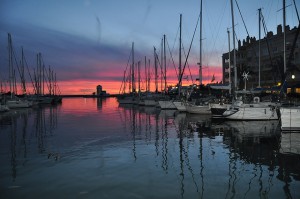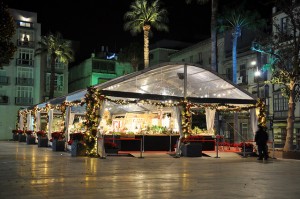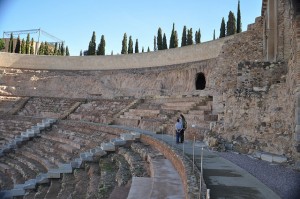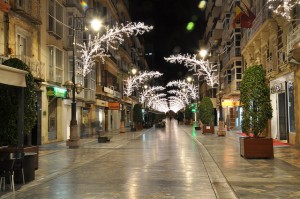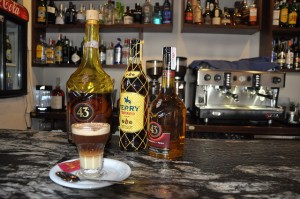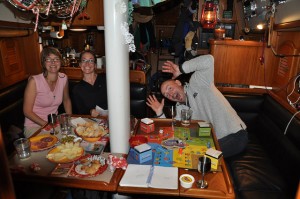We left Gibraltar with a bang and a flash, in the midst of a thunderstorm. After the storm passed our stern, we took our electronics out of the oven and proceeded on. We took our time day-sailing up the coast until we got to the marina in Ayamonte, Spain – by far the least expensive marina we’ve visited in the past 15 months. The equivalent of $15 a day! This made the decision to stay a few days much easier.
We spent our time visiting the nearby restaurants, playing catch with Dante and doing the usual: provisioning, laundry, boat repairs and maintenance. Dante also had time to practice his Spanish by buying mom and dad Christmas presents on his own. We met other cruisers while docked – a nice English couple and also a friendly Spanish couple, the first Spanish cruising couple we’ve met. We offered to buy them a drink in exchange for information on anchorages up the coast. They didn’t speak English so I did the translating over tapas and drinks. They got a kick out of hearing our American accents which sounded different to them than the British English accent. They couldn’t understand a word we said when Darold and I were talking and translating to each other and to them it sounded like “tickety tackety tickety tack.”
We moved on after 4 days and anchored for two days along the coast until we arrived in Cartagena, Spain. We planned on only staying for 3 or 4 days but we were really tired and Cartagena was so charming, we decided to stay through Christmas. Cartagena, the Spanish name for “New Carthage,” is an ancient city, which was founded by the Phoenicians and later used as a base for the Hannibal before he made his way over the Alps (along with his 37 elephants) to attack Rome. There are also Roman ruins throughout the city including a Roman theatre, which had remained hidden for hundreds of years as houses had been built on top of it. History is everywhere in the city. As we had a drink at a bar next to the Roman theater, the waiter took us on a tour of the building, which included a private dining room in an old Roman cistern and a clear floor showing a Roman well. The marina was a short walk to the city center, which was car-free and charming with its tiled streets lined with shops.
The city was decked out for Christmas with lights draped across the narrow walkways. We arrived on a Sunday in time to join the locals in post-church tapas. Spain isn’t super easy for vegetarians (they love their fish and meats) but fortunately just put olive oil, salt, bread and olives in front of Darold and he’s a happy man. Dante and I enjoyed croquettas de bacalao (fish fritters) and patatas bravas (twice fried potato pieces with a tomato relish). We also came to love the local coffee called café asiatico, which is lemon and cinnamon-infused coffee with condensed milk, brandy and the locally made liquor “Licor 43.” It is served in a special glass that highlights each layer of the drink. It is so pretty, it almost seems a shame to stir it before drinking! Spanish wine and “cava” (champagne) is also delicious and unbelievably cheap. One very decent bottle of wine will run you less than 5 Euros ($7.50) – and you can find good wines even less expensive than that. When going to dinner, you can buy an entire bottle of wine for the same price as a cheap glass back at home in California. We spent our time in Cartagena on some boat repairs (fixing a leak in the forward water tank, adding a European electrical outlet to the boat), exploring the town, and hanging out with some new friends we met from the United Kingdom: Suella, Stephen and their son Iaian from 2 Blue. You know you’ve met like-minded friends when you can spend 8 hours eating, drinking and talking with each other and not run out of things to say! We repeated this ritual several times. Dante and Iain enjoyed some serious kid time, something that Dante has been missing since we were in Cape Cod. I suppose it’s good we don’t meet people like this all the time or our livers wouldn’t ever recover.
Darold and I also enjoyed a couple of “date nights.” When we are in a secure marina, we feel comfortable leaving Dante on the boat while we go out to dinner or drinks. The Spanish love to go out and the city is always filled with people, including families with kids, late into the evening. Their evenings start late, many restaurants not opening for dinner until after 8 or 9 o’clock. There are bars and “churros con chocolate” stands open until the wee hours. The city had set up an enormous nativity scene that was animated and highly detailed. The Spanish like to dress up when they go out. And when I say “go out” I mean anytime they step outside their apartment. The Spanish also take pride in how well their children are dressed, and you’ll see a lot of adorably dressed babies and young children with siblings often in matching outfits. There are a lot of children’s clothes boutiques as a result. Many shops are still closed during mid-day (from around 2-5pm) and open again from 5-9pm. As a consequence, many shops aren’t open early in the morning. Early one morning Dante and I went in search of a Spanish bakery and we had to wait outside until it opened at 9am. It was worth the wait, however. Spanish bread is delicious and so are their pastries. We tried palmeras con chocolate (a flaky pastry shaped in a palm leaf, coated in chocolate), cordiales (a moist Christmas cookie with dried fruits), a flaky pastry in a twist infused with honey and covered in powdered sugar (I don’t know the name of it, but will just call it delicious!) Also worth mentioning is Spanish coffee. The espresso machines look like the same ones we have back in the U.S., but the coffee seems so much more aromatic. In fact, since arriving in Europe (including our stopover in the Azores) we haven’t had a bad cup. (So much for all that weight we lost at the beginning of our trip.)
Christmas Eve we joined a pot luck barbeque of other cruisers on the docks of the marina. I brought homemade Tollhouse chocolate chip cookies. Most non-Americans we’ve met have never had them and they are invariably a hit. After the barbeque, we proceeded to Christmas Eve mass at the local Catholic Church. It is very much like mass in the United States (stand up, sit down, stand up, repeat) though we understood a lot less of it. Still, it was fun to be with the locals celebrating Christmas with them. Families were streaming in and out of the church (with their matching, well-dressed children) and as we were leaving mass, we noticed a statue of a saint holding a square rigged-ship. The sign said that it was San Telmo, patron saint of navigators. I think it’s time for a new saint statue for Benevento.
Christmas Day was great, and this year I’d planned ahead by shopping in the U.S. before we made our Atlantic crossing. This was a big difference from last year where Darold and I were searching all over Panama City for Dante’s Christmas gifts. I had even bought a mini (fake) Christmas tree in Lisbon, complete with mini decorations this year. Dante, our new electronics wizard rigged up a circuit with an LED light so that the tree had a star at the top. After Christmas it was time to move on. It’s easy to develop “sticky lines” in a city like Cartagena but with only a limited amount of time left to cruise the Mediterranean, we have to make some tracks…
For more pictures of Cartagena, go to our Flickr site: https://www.flickr.com/photos/easethemain/sets/72157649962742435/
For pictures of sailing up the Spanish coast toward Cartagena (including Ayamonte) go to our Flickr site here: https://www.flickr.com/photos/easethemain/sets/72157649893059106/
